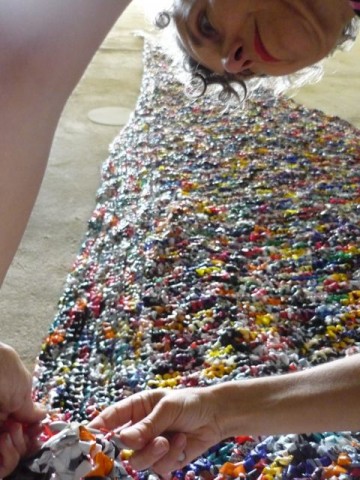Chiara Fiorini
ATTRAVERSARE L'ESTATE
August 27, 2010 – October 16, 2010
Fiorini has experience with wondrous clothes; previous examples include her long dress consisting of stitched together ivy leaves or soft cotton wool balls, this time it’s colourful plastic bags. Her creations in each case have a magical and enigmatic effect. She fashions clothes that radiate a peculiar charm, the idea behind which is purely the idea of wearing them.
Art and fashion have shared a long history, particularly since the age of modernism. Andy Warhol created whole dresses out of silkscreen prints – the Campbell’s soup dress was made entirely out of paper. Joseph Beuys created the Felt Suit as an object and a reference to his personal survival story. In contrast sits the ironic and playful ‘pain couture’ by Jean-Paul Gaultier. All, however, have one thing in common: these artistic clothes transport an archetypical, timeless idea. The notion that these clothes may be worn is incidental; more often than not they are impossible to wear. Fashion is created through dynamic and transience, through a longing for the new but also through the continual recycling of tried and tested ideas. Art refers to other contents.
Cinderella, Heracles and Siegfried are just three examples from world literature whose unique clothes or coverings are inherent to their personal histories. Clothes that offer magical powers to their wearer have appeared time and again in myths and fairytales since they were first put down in writing. Cinderella’s glass shoe, which led to her meeting with prince charming, the Nemean Lion’s fur that made Heracles almost invincible, or the bathing of Siegfried in dragon’s blood to render him impossible to harm save for in one place, all offer archetypical notions and wishes which refer beyond our earthly existence.
With ‘Attraversare l’estate’, Fiorini plays on the registers of our collectively known representations and phenomena. The strong effect of the dress and the playfully strewn artefacts triggers questions in the instantly captivated viewer: who does this dress belong to? Where is the person to whom this dress belongs? These open questions serve as stepping-stones for the individual’s personal interpretation. Just as every item of clothing carries simultaneously within it an individuality and conformity, so access to the installation by Fiorini requires a collectively characterised personal approach.
Art and fashion have shared a long history, particularly since the age of modernism. Andy Warhol created whole dresses out of silkscreen prints – the Campbell’s soup dress was made entirely out of paper. Joseph Beuys created the Felt Suit as an object and a reference to his personal survival story. In contrast sits the ironic and playful ‘pain couture’ by Jean-Paul Gaultier. All, however, have one thing in common: these artistic clothes transport an archetypical, timeless idea. The notion that these clothes may be worn is incidental; more often than not they are impossible to wear. Fashion is created through dynamic and transience, through a longing for the new but also through the continual recycling of tried and tested ideas. Art refers to other contents.
Cinderella, Heracles and Siegfried are just three examples from world literature whose unique clothes or coverings are inherent to their personal histories. Clothes that offer magical powers to their wearer have appeared time and again in myths and fairytales since they were first put down in writing. Cinderella’s glass shoe, which led to her meeting with prince charming, the Nemean Lion’s fur that made Heracles almost invincible, or the bathing of Siegfried in dragon’s blood to render him impossible to harm save for in one place, all offer archetypical notions and wishes which refer beyond our earthly existence.
With ‘Attraversare l’estate’, Fiorini plays on the registers of our collectively known representations and phenomena. The strong effect of the dress and the playfully strewn artefacts triggers questions in the instantly captivated viewer: who does this dress belong to? Where is the person to whom this dress belongs? These open questions serve as stepping-stones for the individual’s personal interpretation. Just as every item of clothing carries simultaneously within it an individuality and conformity, so access to the installation by Fiorini requires a collectively characterised personal approach.

